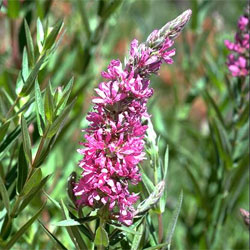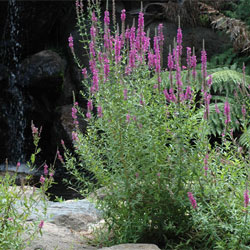Lythrum salicaria
 |
 |
Purple Loosestrife
Lythrum salicaria, known commonly as Purple Loosestrife, is an interesting species native not only to Australia but widespread in Europe, Asia and North America. It is a herbaceous perennial related to Lagerstroemia (crepe myrtle) and known from ancient times. Investigation of the meaning of the name leads back into the literature of many countries and is an example of the fascinating history behind names.
 One
record of the use of Purple Loosestrife in medicine and tanning is found in
Dr Lindley's Flora Medica (1838). The old English common name indicates
a use as an astringent, but Lythrum has strange connections. The Greek
word lythron meant blood in a sinister sense, i.e. impure, as from
flowing battle wounds and other causes. As none of this group of plants has
blood-red flowers, it is possible the name indicated that the plant was used
for stopping blood. A reference found in a Chinese book suggests this.
One
record of the use of Purple Loosestrife in medicine and tanning is found in
Dr Lindley's Flora Medica (1838). The old English common name indicates
a use as an astringent, but Lythrum has strange connections. The Greek
word lythron meant blood in a sinister sense, i.e. impure, as from
flowing battle wounds and other causes. As none of this group of plants has
blood-red flowers, it is possible the name indicated that the plant was used
for stopping blood. A reference found in a Chinese book suggests this.
The species favours wet situations such as swampy ground and the water's edge, but will persist in dried-out land and is long lived, wild or cultivated. In Australia it grows in the eastern states and Tasmania, often occurring in drifts. Not far from Canberra it grows by the roadside, indicating damp ground, though it is not conspicuous in years of drought. After several showery seasons it spreads freely, and is easily seen when in flower between January and March. The light-purple spikes shine out among surrounding grassy herbage which is turning brown at this time.
As may be expected of a widely distributed plant, Lythrum salicaria is an easy garden plant, thriving in any soil and generally healthy. It is a beautiful subject for late summer colour in a border, shrubbery, large pond or slow-moving water. If well-watered and reasonably sheltered, it reaches over 2 m high. It will also grow in coastal gardens.
Unlike many perennials which grow bare in the centre with age, this plant forms a bushy and well-shaped clump. The tall stems are strong, branching freely, and they tend to curve inwards in a self-supporting manner so that staking is not necessary.
Lateral buds develop while the main spikes are flowering and these continue the season till near the end of March. The soft, light green foliage often turns red in aging towards autumn. Top growth dies down for winter and should be cut back to ground level.
Propagation is by root division or seed, and self-sown seedlings often appear in open ground. If desired, cuttings may be taken from non-flowering laterals in midsummer and struck outdoors in shade. This species is not grown commercially in Australia as often as might be expected, though in other countries named garden varieties have been grown for years. These range from white to pink and deep purple, and include double flowers. Short flower spikes last well as a cut flower in water.
Based on text by ANBG staff (1972)
Name meaning: Lythrum salicariaLythrum - from one of the Greek words for blood, with complex meaning; salicaria - willow-like, referring to the leaves or flower spikes |
![An Australian Government Initiative [logo]](/images/austgovt_brown_90px.gif)

